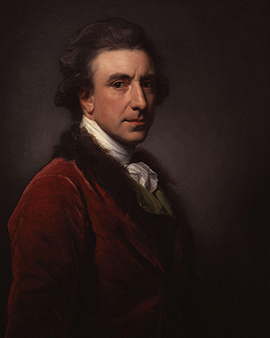Although there are always writers who make a career as politicians, Sir Nathaniel Dance-Holland is one of the very few painters who gave up his passion for the cabinet. Yet he comes from a successful family of artists.
Nathaniel was born in 1735 as the younger son of the famous and successful architect George Dance the Elder. The latter was the head of the building and surveying office of the city of London from 1735 until his death. He is also the arquitect who designed the Mansion House, the office of the Lord Mayor of London, whose gorgeous "Egyptian Hall" still attracts many visitors today. His fifth son, known as George Dance the Younger, followed in his father's footsteps and also made a name for himself as an architect. Nathaniel's older brother James was a famous actor. Therefore the young Nathaniel didn't meet with much resistance when he already announced as a teenager that he wanted to become a great painter one day. His father was well-off and could afford to let his talented son be educated by the genre painter and illustrator Francis Hayman who was very well-known at that time. Hayman was strongly influenced by the French Rococo, whose elements also shimmered through in the works of Dance.
But Hayman only laid the foundation for Nathaniel's education. He then went to Rome to continue his studies. There he met the history painter Angelica Kauffmann, who was born in Switzerland and grew up in Lombardy. The artist was fascinated by her and she also influenced him stylistically. After his return from Rome, Nathaniel's career as a painter began, hardly ever returning to London, with his most famous works. First he portrayed King George III and then the famous Captain James Cook, who is considered to be the discoverer of Australia. Cook's portrait is regarded as his masterpiece and is now hanging in the National Maritime Museum in Greenwich.
At the same time, he founded the "Royal Academy of Arts" with his brother George, Angelika Kauffmann, who in the meantime has also returned to London, and numerous other artists, which still plays an outstanding role in the promotion of art today. In 1790 Nathaniel married Harriet Dummer, whose first husband was a member of the British Parliament. A short time later, he himself began to become politically active and was elected a member of parliament in the same year. A status he retained until his death in 1811. For his achievements as an artist, patron of the arts and politician, he had been ennobled a few years earlier and appointed "Baron for life". He had adopted the suffix "Holland" during his time as a politician to express his great admiration for Charlotte Holland, about whom little is known today.
×





.jpg)
.jpg)
_wife_of_King_George_III_1775_-_(MeisterDrucke-96839).jpg)
_wife_of_King_George_III_1775_-_(MeisterDrucke-96839).jpg)
.jpg)
.jpg)
.jpg)
.jpg)
_-_(MeisterDrucke-898706).jpg)
_-_(MeisterDrucke-898706).jpg)
.jpg)
.jpg)
_1st_Baron_Clive_1773_-_(MeisterDrucke-105427).jpg)
_1st_Baron_Clive_1773_-_(MeisterDrucke-105427).jpg)
.jpg)
.jpg)
.jpg)
.jpg)
.jpg)
.jpg)
_1st_Baron_Clive_c1773_-_(MeisterDrucke-75076).jpg)
_1st_Baron_Clive_c1773_-_(MeisterDrucke-75076).jpg)
.jpg)
.jpg)
 - (MeisterDrucke-228973).jpg)
 - (MeisterDrucke-228973).jpg)
.jpg)
.jpg)
.jpg)
.jpg)
.jpg)
.jpg)
.jpg)
.jpg)
.jpg)
.jpg)
 of the Worshipful Company - (MeisterDrucke-545960).jpg)
 of the Worshipful Company - (MeisterDrucke-545960).jpg)
_English_captain_and_traveling_com_-_(MeisterDrucke-1081861).jpg)
_English_captain_and_traveling_com_-_(MeisterDrucke-1081861).jpg)
.jpg)
.jpg)
.jpg)
.jpg)
.jpg)
.jpg)
.jpg)
.jpg)
.jpg)
.jpg)
.jpg)
.jpg)
.jpg)
.jpg)
.jpg)
.jpg)
.jpg)
.jpg)
.jpg)
.jpg)
.jpg)
.jpg)
 - (MeisterDrucke-606782).jpg)
 - (MeisterDrucke-606782).jpg)
.jpg)
.jpg)
.jpg)
.jpg)
.jpg)
.jpg)
.jpg)
.jpg)
 - (MeisterDrucke-665064).jpg)
 - (MeisterDrucke-665064).jpg)
.jpg)
.jpg)
.jpg)
.jpg)
.jpg)
.jpg)
_-_(MeisterDrucke-1133853).jpg)
_-_(MeisterDrucke-1133853).jpg)
.jpg)
.jpg)
.jpg)
.jpg)
.jpg)
.jpg)
.jpg)
.jpg)
.jpg)
.jpg)
.jpg)
.jpg)
.jpg)
.jpg)
.jpg)
.jpg)
.jpg)
.jpg)






